Introduction
In the dynamic landscape of data management, the ability to share insights effectively can set organizations apart from their competitors. Power BI’s “Publish to Web” feature opens the door to a broader audience, enabling companies to distribute interactive reports with ease. However, this opportunity comes with significant responsibilities, particularly regarding data privacy and security.
As organizations navigate the complexities of sharing information publicly, understanding the nuances of this feature becomes imperative. From ensuring compliance with regulations to customizing reports for maximum impact, this article delves into practical strategies and best practices that empower organizations to harness the full potential of Power BI while safeguarding their sensitive data.
By addressing these critical aspects, businesses can enhance transparency and engagement, ultimately driving informed decision-making and fostering growth.
Understanding Power BI Publish to Web
By choosing to publish Power BI report to web, organizations can distribute a BI publication that offers a significant chance to share interactive visualizations with a broader audience, thus improving access to essential data insights. This capability is particularly advantageous for disseminating information to stakeholders or the public without the need for them to possess Power BI licenses. However, it is essential to recognize that when you publish Power BI report to web, the reports become accessible to anyone with the link.
This openness can significantly enhance transparency, fostering trust and engagement with the audience, yet it simultaneously raises critical privacy concerns that must be addressed, especially regarding the uploading of images with embedded location information (EXIF GPS). As the landscape of information sharing continues to evolve, particularly in 2024, organizations must tread carefully, balancing the benefits of wider access against the imperative of protecting sensitive information. Significantly, the dataset utilized in BI analyses frequently includes merely four count measures, which can restrict the breadth of understanding offered.
Additionally, as emphasized by a confidential source, the enhanced usage statistics document only encompasses instances that have been accessed in the past 30 days, raising concerns for users seeking more comprehensive usage information. Understanding these complexities is vital before embarking on the publication process. Utilizing our BI services, including the 3-Day BI Sprint for rapid document creation—which enables organizations to generate professional documents in just three days—and the General Management App for thorough management, can assist in streamlining your reporting processes and improving actionable understanding.
The integrated usage metrics summary accessible in the BI Service enables organizations to obtain usage information without requiring administrative privileges, demonstrating a practical approach to address these challenges. Furthermore, it is crucial to tackle the difficulties in utilizing insights from BI dashboards, such as time-consuming document creation and possible information inconsistencies. By exploring the implications of how to publish Power BI report to web, organizations can develop strategic approaches to maximize its benefits while safeguarding their information integrity.
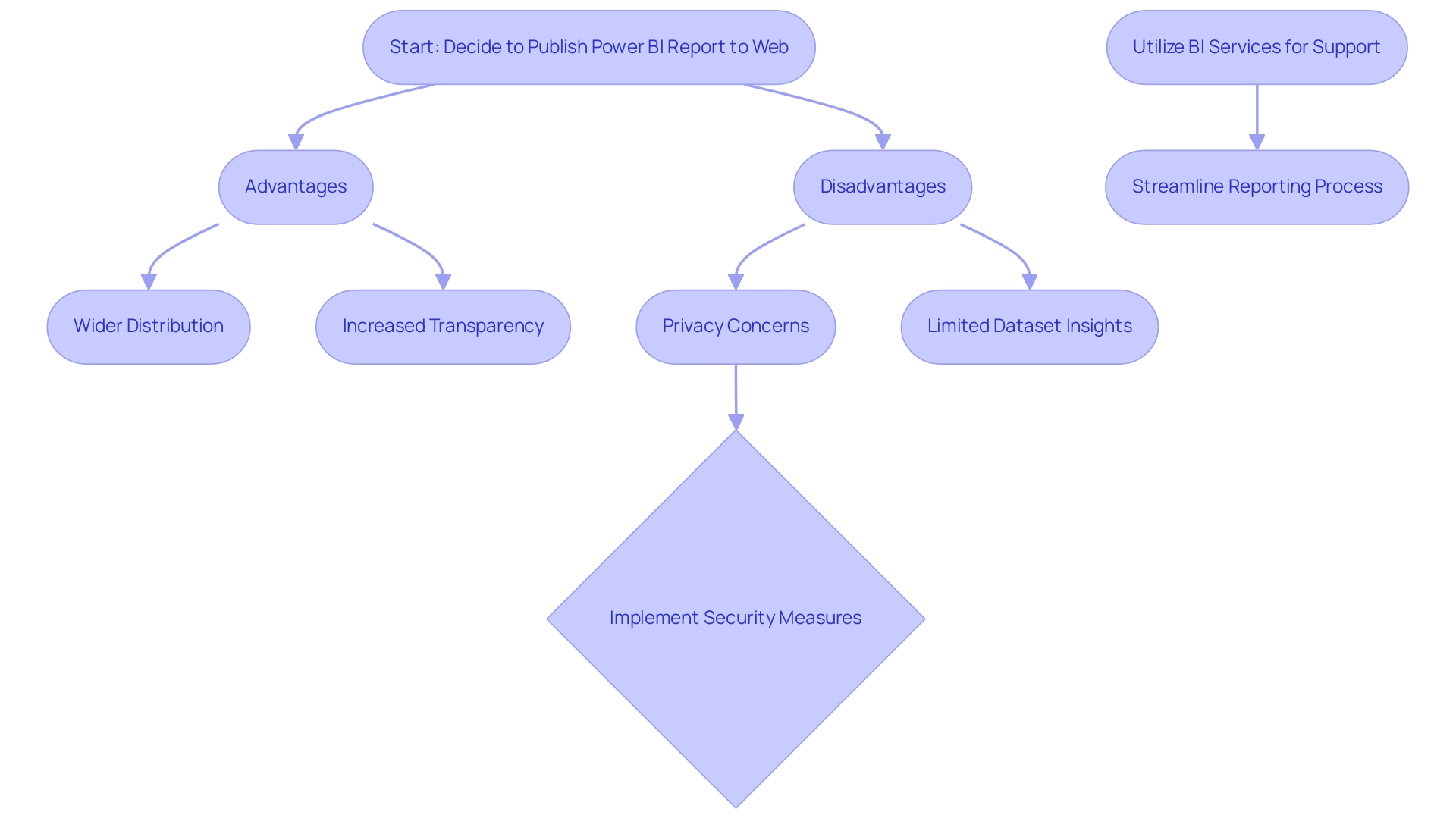
Step-by-Step Guide to Publishing Your Power BI Report
-
Open Your Report: Begin by accessing the BI report that you intend to publish. Confirm that it is polished and prepared for audience engagement, ensuring that it addresses any inconsistencies in information and provides actionable insights.
-
Select ‘File’: Click on the ‘File’ menu located in the upper left corner of the Power BI interface.
-
Choose ‘Publish to Web’: From the drop down menu, select the ‘Publish to Web’ option. A dialog box will appear, outlining the public nature of the document and its implications, which is crucial for maintaining data governance and trust.
-
Create Embed Code: Click on the ‘Create embed code’ button. Ensure you acknowledge the implications of making your document publicly accessible before proceeding, as this can enhance your insights’ reach and impact.
-
Copy the Link: After the embed code is generated, copy the provided link. This link will serve as the gateway for others to access your document, facilitating informed decision-making.
-
Share Your Report: You can disseminate the link through email, social media platforms, or by embedding it on a website. Be sure to inform your audience that the document is publicly accessible, as Christian Ofori-Boateng aptly notes,
Knowing how to publish Power BI report to web will enable you to provide readers, customers, and relevant parties access to responsive visualized information that automatically updates when you change the information within the Microsoft software.
Additionally, it’s worth noting that in January 2017, a statistic recorded indicated that 5% of organizations were effectively sharing BI reports online. Moreover, the case study titled ‘How to Create Interactive Dashboards‘ offers significant perspectives on developing and labeling dashboards, which can improve your information presentation and operational efficiency. Lastly, while percentiles and quartiles can be visualized using Boxplots, Power BI does not provide a native method to create them, which is an important consideration for users aiming for comprehensive analysis.
In today’s data-rich environment, failing to utilize information effectively can place your organization at a competitive disadvantage. Embracing Business Intelligence can transform raw data into actionable insights, driving growth and innovation.
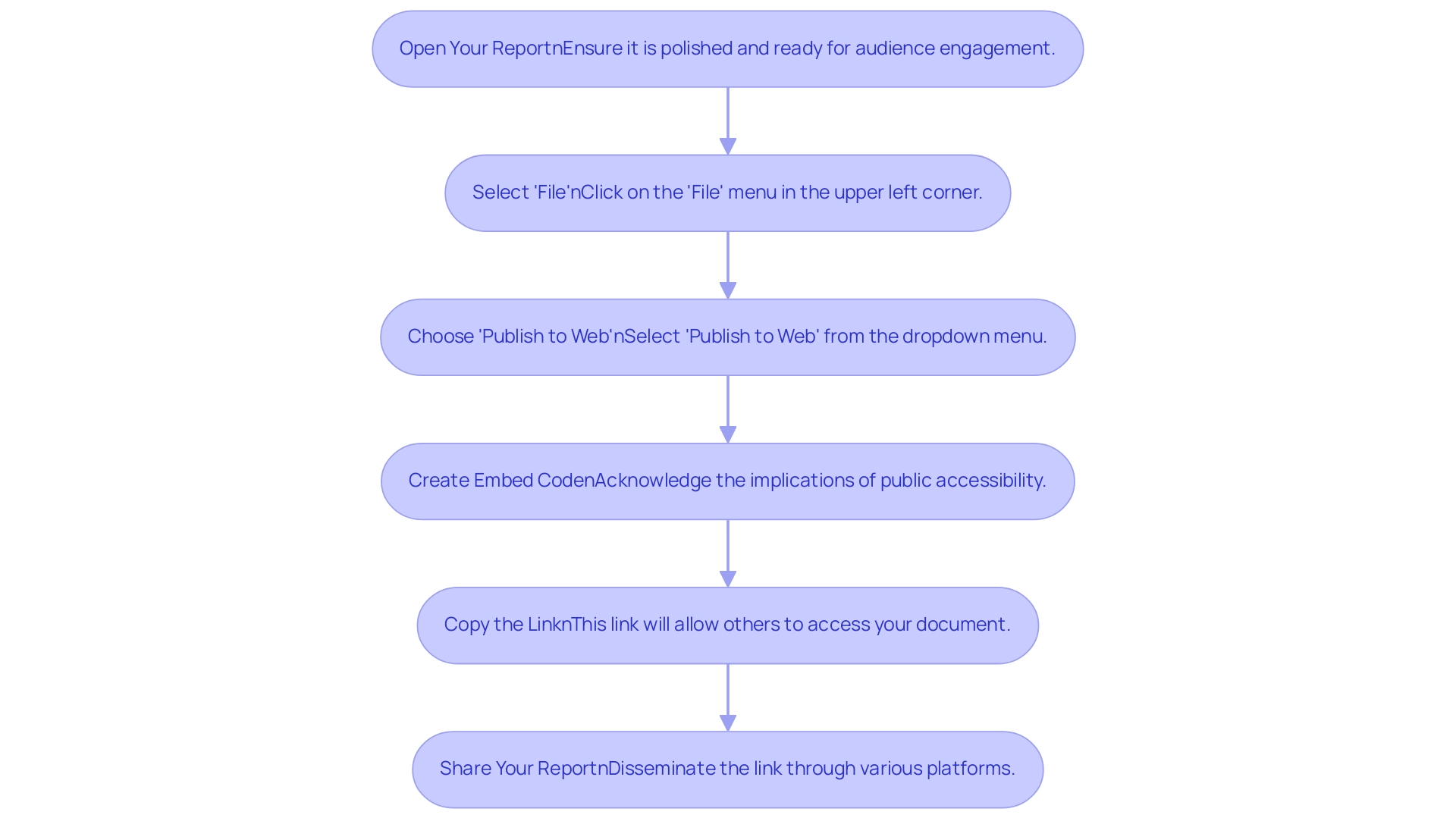
Security and Privacy Considerations for Published Reports
Before publishing your Power BI document, it is essential to address several key security and privacy considerations:
-
Data Sensitivity: Assess the document for any sensitive or confidential information. Remember, anyone with access to the link can view the document, potentially exposing your organization to risks. Statistics have indicated that sensitivity breaches in published documents can result in significant consequences, highlighting the necessity for vigilance. Historical events, such as the 1984 TRW hack that led to the theft of 90 million records, highlight the significance of strong information protection measures.
-
Compliance: Confirm that sharing your document aligns with your organization’s governance policies and complies with relevant regulations such as GDPR. Non-compliance can lead to substantial fines and legal consequences, as demonstrated in previous settlements involving breaches, such as the $750,000 agreement by Raleigh Orthopedic Clinic in 2016. Additionally, staying informed about current data privacy regulations is crucial to guarantee continuous compliance and reduce risks.
-
Monitoring Access: Regularly review who has access to your document. Be proactive in managing permissions and be ready to withdraw the document from public access if any concerns arise. A study indicated that remote employees have been associated with security breaches in 20% of organizations during the pandemic, emphasizing the significance of access control.
-
Updating Documents: Keep in mind that once your document is published, it remains static. Any updates or changes made after you publish Power BI report to web will not be reflected until you republish the document. This limitation necessitates careful planning and regular updates to ensure that the published content remains accurate and relevant. The case of Providence Health & Services, which settled a case in 2008 for $100,000 due to insufficient information governance, serves as a reminder of the potential financial repercussions of neglecting these responsibilities.
-
Visitor Comments and Privacy Practices: When receiving comments on your reports, be aware that details such as the visitor’s IP address and browser user agent string are collected to assist in spam detection. Additionally, an anonymized string created from the email address may be shared with services like Gravatar, which allows users to display their profile pictures publicly once comments are approved. Comprehending these practices is vital for preserving transparency and trust with your audience.
-
Image Upload Privacy: Be cautious when uploading images that may contain embedded location information (EXIF GPS). This information can inadvertently expose sensitive details about locations, which could compromise privacy. It is recommended to remove such metadata prior to uploading images to guarantee that no unintentional location information is disclosed publicly.
-
Challenges in Utilizing Information: While BI dashboards can offer valuable information, obstacles such as time-consuming document creation, inconsistencies in information, and the absence of actionable guidance can impede effective decision-making. Tackling these challenges is essential to completely utilize the features of BI tools and enhance data governance.
By considering these factors, you can greatly improve the security and compliance of your BI analyses, reducing risks and guaranteeing that you maintain the highest standards of data governance.
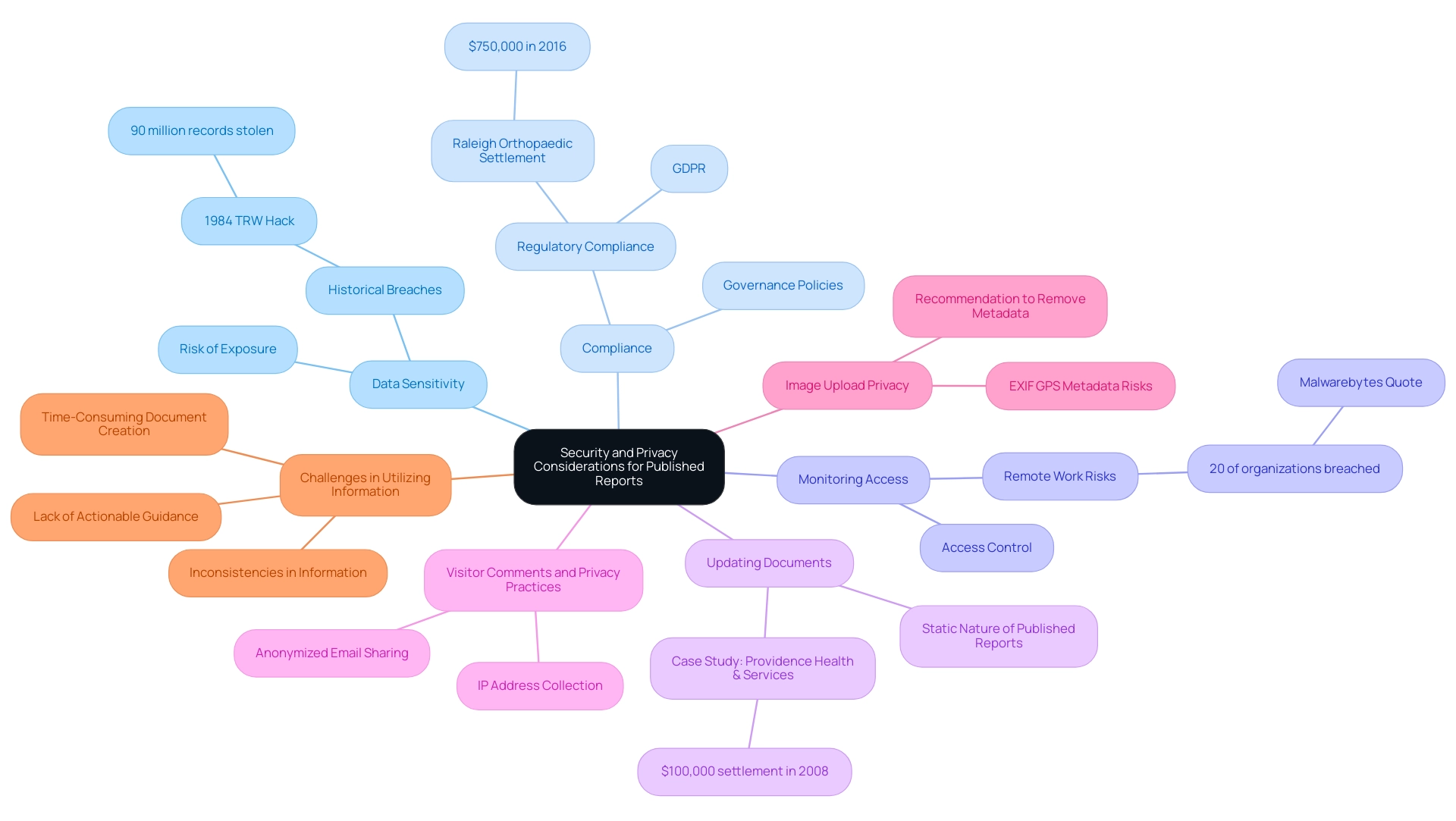
Customizing Your Published Power BI Report
Modifying your published BI visualization is crucial for maximizing its effect and ensuring that your audience gains valuable knowledge. With 1,882 users online, the relevance and demand for efficient BI customization are clear. Here are key steps to enhance your reports:
-
Adjust Visualizations: Tailor your charts, graphs, and tables to clearly convey the insights you wish to communicate. Effective visualizations should not only represent information accurately but also engage viewers by highlighting key trends and metrics, a capability bolstered by our Power BI services.
-
Add Filters: Implement filters that empower viewers to interact with the data, allowing them to focus on specific areas of interest. This interactivity is crucial for enhancing user engagement and ensuring that the document meets diverse viewer needs. As mentioned by Pat, a Microsoft Employee, “For your daily tasks transferring files, I’m guessing Automate could assist you there, but I don’t know the specifics of what you are doing,” highlighting the significance of customized solutions in document personalization. Leveraging tools like Power Automate can streamline workflow automation, providing a risk-free ROI assessment for your operations.
-
Branding: Infuse your organization’s branding elements—such as logos and color schemes—into the document. Consistent branding not only maintains a professional appearance but also strengthens brand recognition and viewer trust.
-
Set Up Navigation: Develop a clear navigation structure within your document to improve user experience. A well-organized layout helps viewers seamlessly transition between different sections, enabling them to find information quickly and efficiently. Furthermore, to view metrics for all dashboards or documents in a workspace, users must remove default filters that restrict the document to a single dashboard or item. This adjustment, as outlined in the case study on viewing all workspace usage metrics, can lead to better resource allocation and content strategy.
By implementing these personalization techniques, combined with knowledge acquired from our 3-Day Power BI Sprint and General Management App, you can enhance the impact of your Power BI analyses and dashboards, especially when you publish Power BI report to web. Moreover, utilizing Business Intelligence converts raw information into practical knowledge, promoting informed decision-making that encourages growth and innovation. Incorporating RPA solutions can enhance productivity by automating repetitive tasks, allowing your team to focus on strategic initiatives.
By tackling obstacles in information extraction and document creation, these improvements guarantee your summaries connect effectively with your audience.
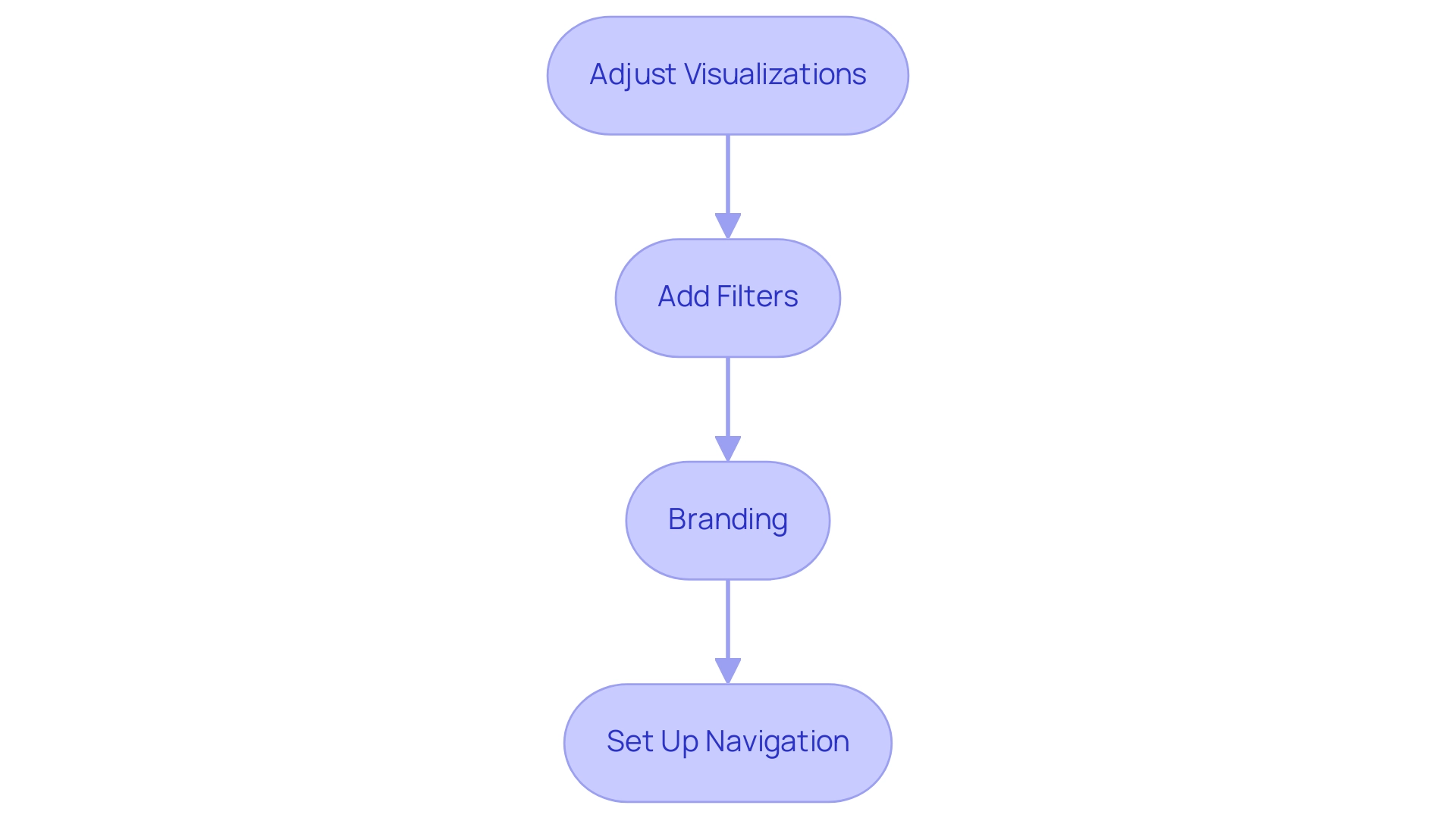
Best Practices for Managing Published Power BI Reports
To effectively manage your published Power BI reports and overcome common implementation challenges, consider implementing the following best practices:
-
Regular Updates: Establish a consistent schedule for reviewing and updating your reports, ensuring they reflect the latest data and insights. This practice not only enhances the accuracy of your documents but also aligns with best practices for managing Power BI files in 2024, ultimately improving operational efficiency.
-
Feedback Loop: Foster a robust feedback mechanism by encouraging viewers to share their thoughts on the documents. This input is invaluable for pinpointing areas needing improvement and allows for adjustments that enhance user experience, ensuring you can tailor your insights to meet business needs effectively.
-
Access Management: Conduct periodic reviews of access to ensure that only essential personnel can view or share the documents. This step is vital in maintaining security and operational efficiency within your organization, mitigating risks associated with data access.
-
Documentation: Keep detailed records of changes made to documents, including the rationale behind these updates. This practice ensures transparency and accountability, fostering trust among stakeholders who depend on these documents and aligning them with your strategic goals.
-
Readability and Consistency: Limit displayed numbers to four numerals and decimal points to two decimal points. This approach significantly enhances readability and consistency across your documents, making them easier to interpret at a glance and improving decision-making capabilities.
-
Leverage RPA: Integrate Robotic Process Automation (RPA) to automate repetitive tasks related to management. By utilizing RPA, you can streamline the data collection and documentation generation processes, significantly reducing the time spent on these tasks and minimizing errors, thus enhancing overall efficiency.
Implementing these strategies will not only enhance the effectiveness of your Power BI outputs but also support your overall business intelligence transformation efforts to publish Power BI report to web. As Kwixand Solutions, a Microsoft Certified Partner, advises, “Get in touch with one of our implementation experts by scheduling a free consultation to see how Kwixand can help support your business’s unique needs and goals.”
Additionally, monitoring performance through key events, such as the Loaded and Rendered events, can provide critical metrics for evaluating the performance of embedded reports, allowing for optimization based on loading and rendering times. This real-world application emphasizes the importance of continuous improvement in your reporting processes, driving data-driven insights essential for business growth.
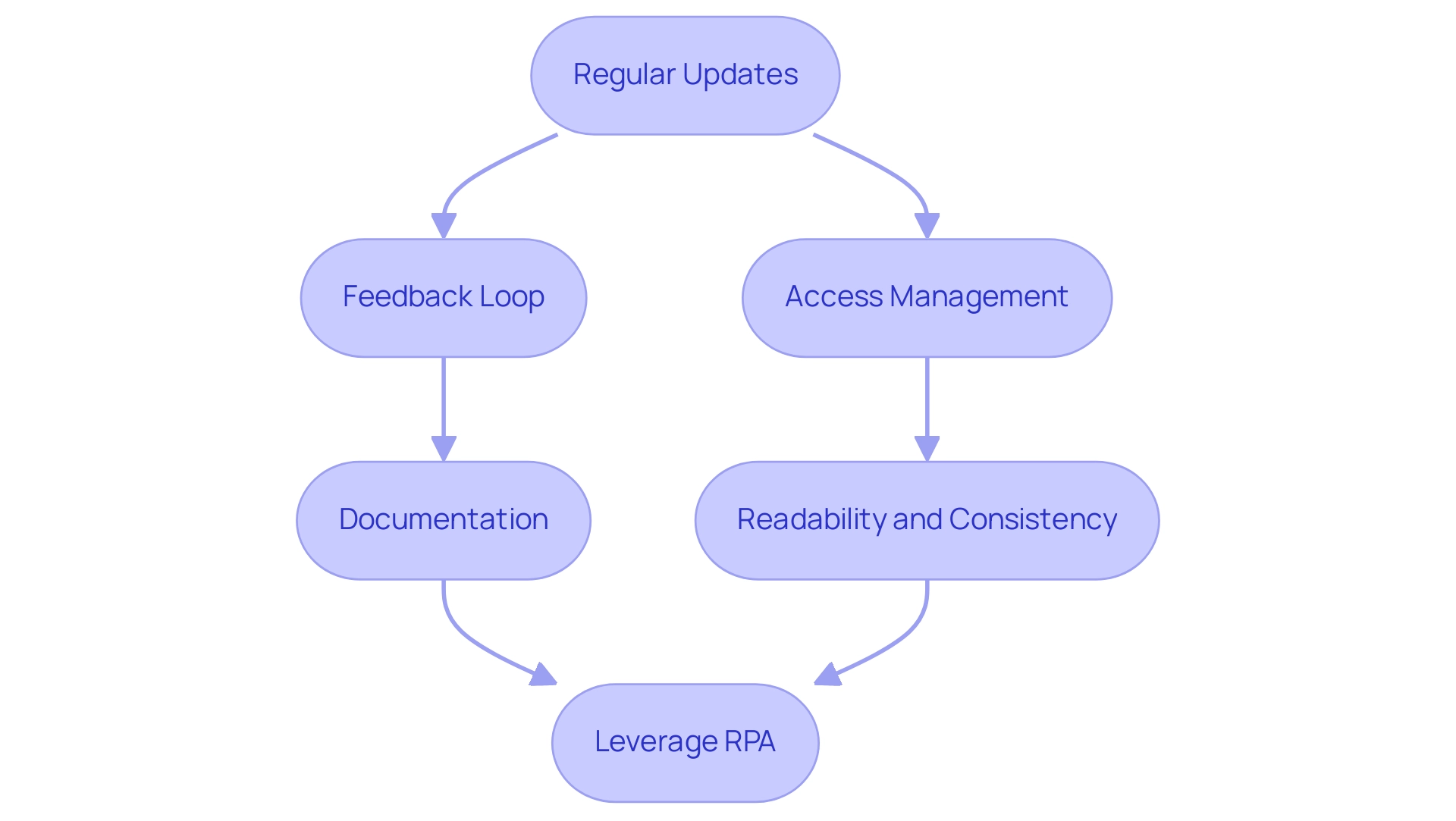
Conclusion
Publishing reports through Power BI’s “Publish to Web” feature can significantly enhance an organization’s ability to share valuable data insights with a wider audience. However, this opportunity comes with the necessity of a thorough understanding of security, privacy, and compliance issues. By recognizing the implications of public access, organizations can make informed decisions that balance transparency with the protection of sensitive information.
Effective customization of reports is crucial for maximizing engagement and ensuring that the data presented resonates with the audience. Utilizing visual enhancements, interactive filters, and branding elements can transform static reports into dynamic tools that drive informed decision-making. Furthermore, incorporating regular updates and establishing a feedback loop will not only keep the reports relevant but also foster a culture of continuous improvement.
In conclusion, navigating the complexities of data sharing with Power BI requires a strategic approach that prioritizes both accessibility and data integrity. By implementing best practices for report management, organizations can leverage the full potential of Power BI while mitigating risks associated with public data sharing. This proactive stance not only enhances operational efficiency but also strengthens stakeholder trust, ultimately leading to more informed decision-making and sustainable growth.

